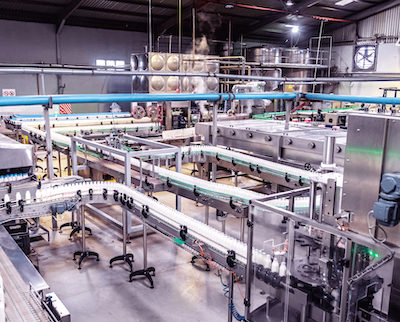News

Large Scale SCADA Migration using Ignition coupled with the Perspective Module
ECS Solutions, Inc., recently completed a large-scale SCADA migration for a fortune 500 food manufacturing client. This upgrade was noteworthy based on the size of the facility-wide project and the fact that it was executed using Inductive Automation’s Ignition platform coupled with the Perspective visualization module as the basis of design. This client has embarked on an enterprise-wide modernization effort which will enable them to maintain and monitor their dozens of facilities. In many ways, this made possible by rapid advancements in plant floor hardware and computing software, commonly referred to as Industry 4.0.
Read More | Posted In: Bakery Industry, Beverage Industry, Case Studies, Chemical Industry, Consumer Goods, Distilleries, Food Industry, Inductive Automation, Life Science Industry, MES, Metals, Metals Industry, News, SCADA

Exploring the Benefits of Enterprise Architecture with Inductive Automation’s Ignition
In today’s rapidly evolving business landscape, companies face numerous challenges such as data fragmentation, operational inefficiencies, and the need for real-time decision-making. To overcome these obstacles, many organizations are turning to enterprise architecture solutions that offer a holistic approach to optimizing operations. One such solution is Inductive Automation’s Ignition, a powerful software platform that offers a wide array of benefits for enterprise architecture implementation. In this blog post, we will explore the advantages of employing Ignition as part of a comprehensive enterprise architecture strategy.
Read More | Posted In: Bakery Industry, Beverage Industry, Blogs, Chemical Industry, Consumer Goods, Distilleries, Food Industry, Inductive Automation, Life Science Industry, Metals Industry, News

Manual Ingredient Additions – Confirmation and Tracking
ECS Solutions, Inc. (ECS), worked with a world leader in nutritional products to tie together the most critical software tools used in their dry ingredient manufacturing. This project merged the capabilities of the existing inventory tracking system with the robust batch processing capabilities in the company’s final assembly area.
The client’s existing inventory management system is a reliable platform which facilitates comprehensive materials tracking, complete with connectivity to their SAP ERP. The final assembly area FactoryTalk View batching system is a prompt-driven batching application designed to steer operators towards the successful assembly of mixes. The overarching goal of this project was to further enhance the consistency in product mixing actions by every operator. ECS tied, the tried and tested inventory tracking functions of the inventory management application, to the programmatic and physical control points provided by the batching control system. The results are streamlined operations for mixing personnel, non-invasive enforcement of the mixing steps and procedures, and more complete data records regarding specific ingredient usage and batch performance.
Read More | Posted In: Bakery Industry, Beverage Industry, Case Studies, Chemical Industry, Consumer Goods, Distilleries, Food Industry, Inductive Automation, Life Science Industry, Metals, Metals Industry

Benefits of a Campaign Manager
Batch processing facilitates the repetitive, tightly controlled manufacture of many things. This type of operation is ideal for large scale manufacturing where products are assembled and modified in a series of stages or steps. When connected to a batch management software system, the number of ingredients, execution stages, and degree of processing complexity which can be handled by relatively unsophisticated operators can be extraordinary. The typical end results for manufacturers are lower cost per unit products with tight quality control and meticulous records of production.
Enterprise resource and scheduling systems are ubiquitous to modern manufacturing organizations. These are frequently mated to plant floor automation systems. For simple batch operations with savvy operators this task can be straightforward, particularly when aided by a batch management solution. However, in operations that require rapid processing or changeover between many in-progress batch orders, this can be challenging. The same is true if batch processing requirements for a single order are large in either complexity or an amount of time that spans beyond the purview of a single operator or team. Integration between the master resource and scheduling system and the batch operating environment can be enhanced using a campaign manager.
Read More | Posted In: Bakery Industry, Beverage Industry, Blogs, Chemical Industry, Consumer Goods, Distilleries, FactoryTalk Batch, Food Industry, Inductive Automation, Life Science Industry, Metals, Metals Industry, News

12 Batch Implementation Design Considerations
Batch systems are used for maximizing quality control, minimizing cost, and reducing loss by manufacturing smaller batches compared to a mass production model, which is why companies in the food and beverage, pharmaceutical, and chemical industries rely on them. The audience of a batch system is varied, and therefore the proper implementation of a batch system needs to consider many factors. From the Plant Manager, Operations, Engineering, and Maintenance to the Operators, all these personas have unique needs that must be considered.
The best practices dictated by standards such as ISA 88 and ISA 95 provide a great guideline or starting point, but these standards do not prescribe how to implement the details of a solution. Therefore, the following is intended to highlight some of the considerations for a system design.

Creating a Robust Equipment Model for Optimal Plant Performance
A plant’s capabilities of what and how products can be manufactured there reside in the capabilities of its equipment, materials, and personnel. These capabilities are captured by the Equipment Model as defined in ISA 88 & 95. Once you capture these capabilities, they are exposed to the recipe author to define how to execute the product manufacturing workflow, which is detailed in the ISA 88 Procedural Model.
Having a well-defined Equipment Model is paramount to enabling the plant’s maximum capabilities while providing the recipe author and operators with an intuitive experience. The Equipment capabilities definition should include the activities that the automation controls system can perform (i.e., Add Water) as well as the activities performed by the operators and other personnel (i.e., Manual Additions, Lab Sample Data, etc.).

Read More | Posted In: Bakery Industry, Beverage Industry, Blogs, Chemical Industry, Consumer Goods, Distilleries, Inductive Automation, Life Science Industry, Metals Industry

Innovative Tools for the Evolving Systems Integrator
The personnel challenges facing virtually every industry over the last few years have been nothing short of astonishing. Proper candidates have become increasingly difficult to court and bring on board. New staff in key roles are tasked to accomplish more with fewer floor operators and technology is increasingly leveraged to close the resulting gaps. This is not unique in history although it may seem that way due to the current media deluge surrounding business intelligence and general-purpose visibility software that makes life easier, smarter, and generally more efficient.
Industrial software is again playing a leading role in the current intelligence revolution. Inductive Automation didn’t invent floor supervisory (SCADA) software, nor did they invent the first responsive, general-purpose web software. However, their current offerings certainly do marry these concepts together in a way that hasn’t existed in industry before. Since 2010 their award-winning Vision Module has enhanced the experiences of factory floor users everywhere, easily connecting complex factory controllers to databases, alarm and reporting systems, and intuitive visualization tools. This product is robust, proven, and works very well for users “inside the industrial network” of many facilities. Today this is coupled with the newer Perspective Module which is an equally powerful tool for use in mobile-responsive applications. For situations where a user may be “outside the industrial network” or simply need to utilize a variety of hardware platforms like PCs, phones, or tablets, Perspective provides an ideal solution.
Read More | Posted In: Bakery Industry, Beverage Industry, Blogs, Chemical Industry, Consumer Goods, Food Industry, Inductive Automation, Life Science Industry, Metals Industry, SCADA

Using Ignition Scripting Libraries
Volumes have been written about the proper use of tools within a software application and how to create projects for maximum efficiency in both development and execution. Senior programmers and leaders of development teams strive to write and deploy robust solutions that are simple, efficient, easy to debug, and easy to adapt in the future.
Ignition is a multi-faceted tool that continues to revolutionize industrial applications. The package includes a powerful scripting tool that has undergone significant upgrades from versions 7 and before and has existed in its current form since version 8. When combined with the software’s other capabilities and using a disciplined approach to the application of all the tools, Ignition can give you efficient and optimized solutions that can solve most SCADA and business integration challenges.
Read More | Posted In: Blogs, Inductive Automation

Ignition Perspective® Module
Human-machine interface (HMI) vendors have been promising a utopia based around web-based technologies for over two decades. The prospect of simply providing a web address to anyone within an organization that leads to a fast-loading, full-power supervisory control and data acquisition (SCADA) system has been on most factories’ wish list for a long time. After all, internet page tools and functionality have far outpaced advancements in SCADA software over the same time. The advancements seem to leap forward every time someone reloads a page, with new widgets and tools available almost daily. When coupled with hardware developments like high contrast screens; enhanced touchscreen operations; and capabilities like Bluetooth, accelerometers, geolocation, and more; a flexible, web-based option has been coveted.
What many casual users fail to understand about HMI solutions is exactly how tightly the software is connected to the factory floor controllers. This connection via high-security networks, VPNs, and masks, can be tricky to navigate, particularly when the architecture is intentionally complex to provide security for the systems. Further, most people don’t realize the architectural complexity of software that link to sometimes multiple databases and remote data sources, where gigabits of proprietary information streams into and out of the SCADA application. It has been the responsibility of the integrators of these solutions to protect would-be users from themselves in a lot of applications. Poorly developed programs could create vulnerabilities to the operation of equipment, expose floor workers to potential risk, and possibly allow trade secrets to escape into cyberspace.
Read More | Posted In: Bakery Industry, Beverage Industry, Blogs, Chemical Industry, Distilleries, Food Industry, Inductive Automation, Metals Industry, SCADA

Systems Integrator Extends Packaging OEM’s Reach
Modern packaging plants want tightly integrated line solutions that run their array of products with fewer operating personnel and the easiest possible means for equipment maintenance. Buyers increasingly purchase large-scale packaging solutions from a single vendor with the expertise to deliver these applications. This presents challenges to equipment OEMs, many of whom offer a few niche or high-level equipment with a menagerie of complimentary machines. Many project suppliers are chosen based on their proven ability to handle a specific, complex operation around which the line is anchored, and the additional machines become part of the overall project by default.
It is generally not feasible for focused machine OEMs to also provide the broad-reach solutions required to fully integrate these complex lines. The breadth of staff required to achieve the expertise for detailed machine control along with the adjacent line operations and IT connections would be unbearably expensive for most machine builders. This is especially true because fully integrated options are not part of every option, so OEMs end up with some of their highest-end staff idle on many of the simpler applications that they tackle. These extended solutions frequently come via a dedicated line systems integrator. ECS Solutions (ECS) is a systems integrator that has delivered a huge variety of manufacturing solutions for more than 45 years including highly integrated packaging lines.
Read More | Posted In: Case Studies, Food Industry, Inductive Automation

DVR Module for Troubleshooting and Continuous Improvement
Effective mass production manufacturing operations involve both monitoring of production processes and continual improvement. ECS Solutions, Inc (ECS) has developed an innovative, powerful tool to help their clients develop peace of mind that their products are being manufactured accurately and efficiently while providing a platform to easily improve future interactions. The Process DVR tool satisfies the modern expectation that anything that can be observed visually should be recorded and easily viewed later. When used effectively, the result is truly optimized production control where the best-trained operators deliver accurate results with the least possible waste.
Data Historian capabilities have been built into many vendors’ SCADA systems for a long time. Astute process engineers can call up trending information that illustrates the states and conditions within an automated system, the multitude of lines crisscrossing an HMI terminal in a way their trained eyes can discern. This is an excellent tool by itself, provided that an operation has personnel who are trained to read and interpret the cryptic information that is returned from a standalone Historian. ECS believed that this was conceptually sound but that a more manageable solution would help to bring wider benefits to their processing clients.
Read More | Posted In: Bakery Industry, Beverage Industry, Chemical Industry, Clean in Place, Digitalization, Distilleries, Food Industry, Inductive Automation, Life Science Industry, SCADA
